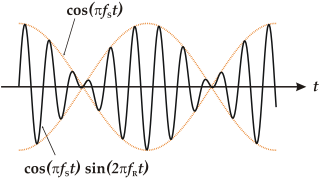An illusion is a distortion of the senses, which can reveal how the mind normally organizes and interprets sensory stimulation. Although illusions distort the human perception of reality, they are generally shared by most people.
An evoked potential or evoked response is an electrical potential in a specific pattern recorded from a specific part of the nervous system, especially the brain, of a human or other animals following presentation of a stimulus such as a light flash or a pure tone. Different types of potentials result from stimuli of different modalities and types. Evoked potential is distinct from spontaneous potentials as detected by electroencephalography (EEG), electromyography (EMG), or other electrophysiologic recording method. Such potentials are useful for electrodiagnosis and monitoring that include detections of disease and drug-related sensory dysfunction and intraoperative monitoring of sensory pathway integrity.
Robert Allan Monroe was an American radio broadcasting executive who became known for his ideas about altered states of consciousness and for founding The Monroe Institute which continues to promote those ideas. His 1971 book Journeys Out of the Body is credited with popularizing the term "out-of-body experience".

Psychonautics refers both to a methodology for describing and explaining the subjective effects of altered states of consciousness, including those induced by meditation or mind-altering substances, and to a research cabal in which the researcher voluntarily immerses themselves into an altered mental state in order to explore the accompanying experiences.
A gamma wave or gamma rhythm is a pattern of neural oscillation in humans with a frequency between 25 and 140 Hz, the 40 Hz point being of particular interest. Gamma rhythms are correlated with large-scale brain network activity and cognitive phenomena such as working memory, attention, and perceptual grouping, and can be increased in amplitude via meditation or neurostimulation. Altered gamma activity has been observed in many mood and cognitive disorders such as Alzheimer's disease, epilepsy, and schizophrenia.
Sensory substitution is a change of the characteristics of one sensory modality into stimuli of another sensory modality.
Neuroprosthetics is a discipline related to neuroscience and biomedical engineering concerned with developing neural prostheses. They are sometimes contrasted with a brain–computer interface, which connects the brain to a computer rather than a device meant to replace missing biological functionality.

In acoustics, a beat is an interference pattern between two sounds of slightly different frequencies, perceived as a periodic variation in volume whose rate is the difference of the two frequencies.
Brainwave entrainment, also referred to as brainwave synchronization or neural entrainment, refers to the observation that brainwaves will naturally synchronize to the rhythm of periodic external stimuli, such as flickering lights, speech, music, or tactile stimuli.

An aura is a perceptual disturbance experienced by some with epilepsy or migraine. An epileptic aura is a seizure.

The Dreamachine, invented in 1959 by Brion Gysin and Ian Sommerville, is a stroboscopic flickering light art device that produces eidetic visual stimuli.
The mismatch negativity (MMN) or mismatch field (MMF) is a component of the event-related potential (ERP) to an odd stimulus in a sequence of stimuli. It arises from electrical activity in the brain and is studied within the field of cognitive neuroscience and psychology. It can occur in any sensory system, but has most frequently been studied for hearing and for vision, in which case it is abbreviated to vMMN. The (v)MMN occurs after an infrequent change in a repetitive sequence of stimuli For example, a rare deviant (d) stimulus can be interspersed among a series of frequent standard (s) stimuli. In hearing, a deviant sound can differ from the standards in one or more perceptual features such as pitch, duration, loudness, or location. The MMN can be elicited regardless of whether someone is paying attention to the sequence. During auditory sequences, a person can be reading or watching a silent subtitled movie, yet still show a clear MMN. In the case of visual stimuli, the MMN occurs after an infrequent change in a repetitive sequence of images.
Brain-reading or thought identification uses the responses of multiple voxels in the brain evoked by stimulus then detected by fMRI in order to decode the original stimulus. Advances in research have made this possible by using human neuroimaging to decode a person's conscious experience based on non-invasive measurements of an individual's brain activity. Brain reading studies differ in the type of decoding employed, the target, and the decoding algorithms employed.
The Ganzfeld effect, or perceptual deprivation, is a phenomenon of perception caused by exposure to an unstructured, uniform stimulation field. The effect is the result of the brain amplifying neural noise in order to look for the missing visual signals. The noise is interpreted in the higher visual cortex, and gives rise to hallucinations.

Electroencephalography (EEG) is a method to record an electrogram of the spontaneous electrical activity of the brain. The biosignals detected by EEG have been shown to represent the postsynaptic potentials of pyramidal neurons in the neocortex and allocortex. It is typically non-invasive, with the EEG electrodes placed along the scalp using the International 10–20 system, or variations of it. Electrocorticography, involving surgical placement of electrodes, is sometimes called "intracranial EEG". Clinical interpretation of EEG recordings is most often performed by visual inspection of the tracing or quantitative EEG analysis.
Thomas Hice Budzynski was an American psychologist and a pioneer in the field of biofeedback, inventing one of the first electromyographic biofeedback training systems in the mid-1960s. In the early 1970s, he developed the Twilight Learner in collaboration with John Picchiottino. The Twilight Learner was one of the first neurotherapy systems.
Audio-visual entrainment (AVE), a subset of brainwave entrainment, uses flashes of lights and pulses of tones to guide the brain into various states of brainwave activity. AVE devices are often termed light and sound machines or mind machines. Altering brainwave activity is believed to aid in the treatment of psychological and physiological disorders.

Trance is a state of semi-consciousness in which a person is not self-aware and is either altogether unresponsive to external stimuli or is selectively responsive in following the directions of the person who has induced the trance. Trance states may occur involuntarily and unbidden.
Virtual hammock describes the effect of using structured sound from two isolated, stationary speakers playing into opposite ears to induce the perception of being in the presence of a single sound source which is moving back-and-forth. Rather than relying solely on a variation in sound amplitude of one speaker compared to the other, the Virtual Hammock effect utilizes a shift in phase of the sound wave of one side compared with the other. This stimulates the same physiological response in the Medial Superior Olive (MSO) portion of the brain stem—the first processing stop for auditory nerves—as is induced by an actual moving sound source. Any waveform within certain frequency bounds can be used to achieve this effect. The specific case of playing sinusoidal waves of different frequencies, which creates a continuously varying sensation of the sound source moving from side-to-side, is referred to as a binaural beat. Similarly, playing square waves of two different frequencies will create a sensation of swaying back and forth.
A cortical implant is a subset of neuroprosthetics that is in direct connection with the cerebral cortex of the brain. By directly interfacing with different regions of the cortex, the cortical implant can provide stimulation to an immediate area and provide different benefits, depending on its design and placement. A typical cortical implant is an implantable microelectrode array, which is a small device through which a neural signal can be received or transmitted.







